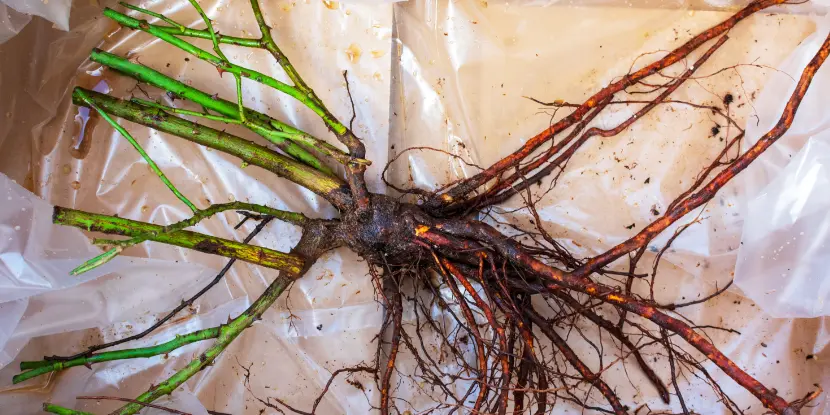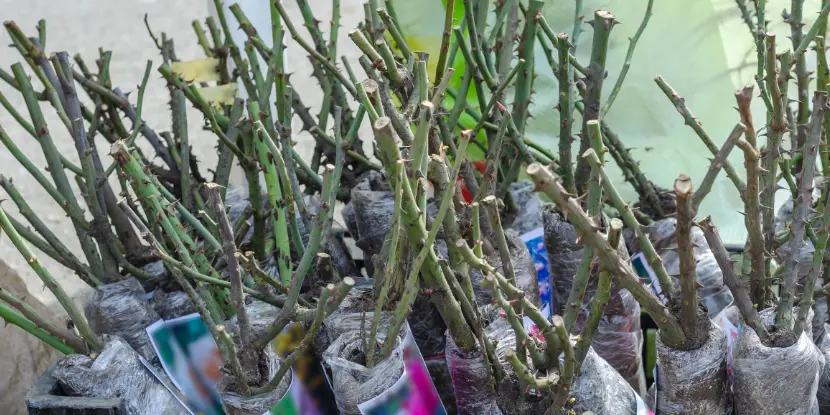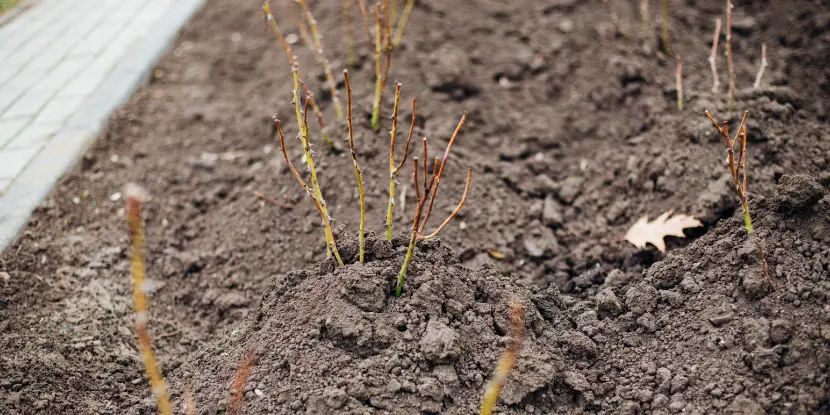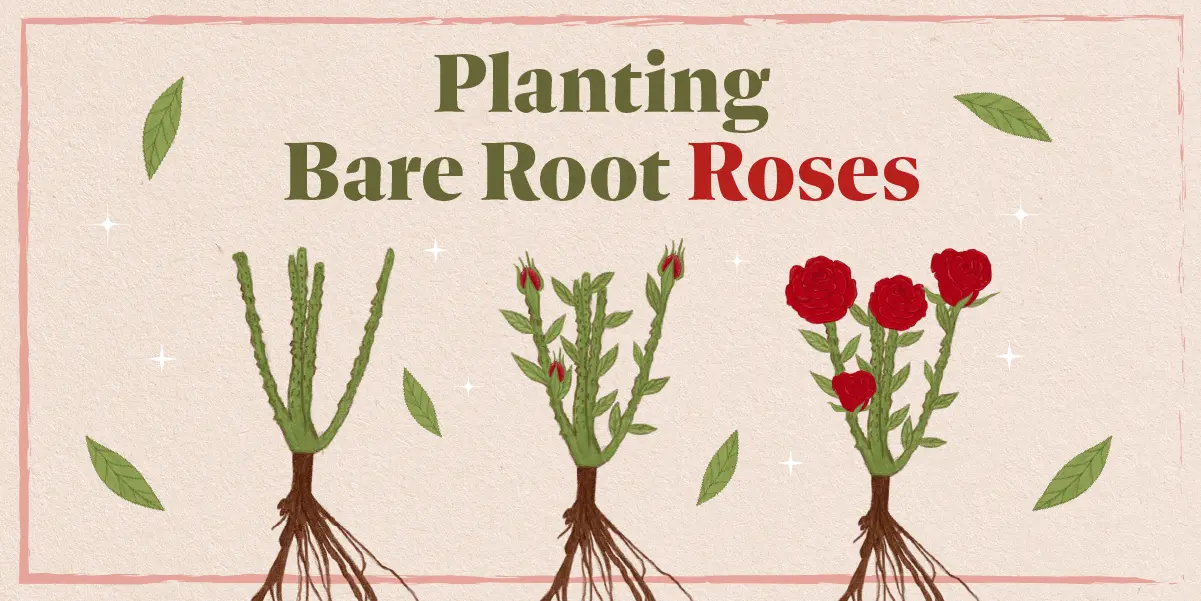A bare-root rose holds some distinct advantages over a potted rose.
This method of growing allows for more robust roots (and ultimately blooms) than potted roses. However, planting the rose requires extra care.
A bare-root rose is produced by pruning a rose bush, removing it from the soil (including the roots), and placing it in a dormant state in a cool, dark, humid environment. The rose bush ships without any soil attached to the roots. Roots must be kept moist and cool until ready to plant, usually within 2–3 weeks.

A bare root rose ready for cold storage.
When to Plant Bare Root Roses in Southern California
The best time to plant bare roots roses is during their dormant season, typically between late fall and early spring. Planting at this time of year allows the rose to establish its root system and prepare for the growing season ahead. Planting during late spring to early summer is also possible.
Choosing a Planting Location
A good location — 3 ft by 3 ft minimum — is critical to growing beautiful, low-maintenance roses. The area should receive at least six hours of sun each day — in other words, half a day or more. Some afternoon shade is beneficial for cooling during the hot summer months.
An open, breezy site is preferable to the corner of a solid wood fence. Superior soil drainage ensures healthy, vigorous root growth. You may want to consider a sloped area or raised bed.
Soil Preparation
- Amend the planting bed with 4 to 6 inches of a blended mixture consisting of 2/3 sandy loam and 1/3 soil conditioner.
- Supplement your planting area with 1 lb of gypsum, about 3 oz of granular soil sulfur, 1.5 oz of magnesium sulfate, and 1.5 oz of rose food.
- You can substitute or modify the rose food with 6 oz of all-natural plant food.
- Topdressing the bed with 3 to 4 inches of mulch will buffer against temperature swings, conserve and retain moisture, minimize weed growth, and replenish much-needed organic matter in the soil.

Stored and dormant bare root roses.
How to Plant a Bare Root Rose Bush
- Select a well-ventilated area of your garden with full sun (at least 6 hours per day) and well-draining soil. Avoid planting in areas with standing water or puddles, as this could lead to root rot.
- Place the bare root rose bush in a bucket of lukewarm water for about 30 minutes before planting. This will rehydrate the roots and encourage growth.
- Make a hole large enough to fit all roots comfortably. The hole should be deep enough so that the crown (where the root and stem meet) is level with the soil surface.
- Place the rose bush into the hole, spreading its roots as much as possible. Gently backfill the hole with soil and lightly press down to remove any air pockets.
- Thoroughly water the newly planted rose bush until the earth is saturated. Continue to water regularly, usually every other day or when the top inch of soil feels dry.
- Spread a thin layer (2-3 inches) of organic mulch, such as leaves, straw, or wood chips, over the soil around the rose bush. This will help retain moisture and keep weeds at bay.
- Clip any dead, damaged, or diseased branches to encourage new growth and shape the rose bush.
- Give the rose bush a balanced fertilizer throughout the growing season, following directions on the package.

Newly planted roses.
Rose Maintenance & Care
- Provide consistent watering, especially during dry spells, to keep the soil evenly moist but not saturated.
- Apply balanced fertilizer or specialized rose fertilizer in early spring, after pruning, and again in late spring or early summer to promote healthy growth and blooms.
- Prune roses in late winter or early spring to remove dead, diseased, or damaged wood, and to shape the plant and encourage new growth.
- Monitor for common rose pests like aphids, spider mites, and thrips. Use insecticidal soap, neem oil, or other organic pesticides to control infestations.
- Prevent common rose diseases like powdery mildew, black spot, and rust by providing good air circulation, avoiding overhead watering, and applying fungicides as needed.
- Keep the area around roses free of weeds that compete for nutrients and water. Mulch around the base of the plant to suppress weed growth.
- Ensure roses are planted in well-draining soil rich in organic matter. Monitor soil pH and amend as necessary to maintain optimal growing conditions.
- In colder climates, provide winter protection by mulching around the base of the plant and wrapping the canes with burlap to prevent damage from freezing temperatures.
Below: Alison Starch demonstrates the technique of planting bare root roses.
FAQs: Planting & Growing Bare Root Roses
Q: What soil do I need to plant bare root roses?
Bare root roses prefer a well-draining, pH-neutral soil high in organic matter and rich in nutrients.
Q: Is it possible to grow bare root roses in containers?
Yes, you can grow bare root roses in containers as long as the container is at least 18 inches deep and wide, has adequate drainage holes, and whose soil meets the requirements above.
Q: How much should I water newly planted bare root roses?
When planting a bare root rose, water it generously to prevent it from drying. Once established, water regularly to keep the soil moist but not saturated. Approximately 1 inch of water per week should be enough for most varieties of bare root roses.
Q: How often should I fertilize my bare root roses?
It’s best to fertilize every four to six weeks during the growing season, using a balanced fertilizer like 10-10-10 or similar proportions.
Q: Does pruning help my bare root roses produce more flowers?
Yes, pruning encourages new growth on your rose bush, resulting in more flowers throughout the growing season.
Q: Are there any pests or diseases I should look out for when growing bare root roses?
Although rare, some pests and diseases can affect your rose plants. These include aphids, scale insects, fungus/mildew, and black spot fungus. Check your plants regularly for signs of infestation and treat them accordingly.
Q: What is the best time of year to plant bare root roses?
The best time of year to plant is late winter or early spring, when temperatures begin to rise, and before they reach their peak heat levels in the summer months. This gives your new plant plenty of time to establish itself before colder weather sets in again.
Q: Do I need special tools for planting a bare root rose?
Basic garden tools are all you need. A shovel, pruners, and rake should suffice, along with a hose or watering can.

